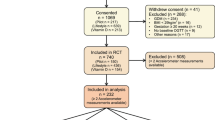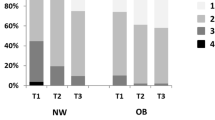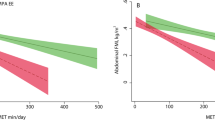Abstract
Background/Objectives:
To measure resting metabolic rate (RMR), activity energy expenditure (AEE), total energy expenditure (TEE) and physical activity pattern, that is, duration and intensity (in metabolic equivalents, METs) of activities performed in late pregnancy compared with postpartum in healthy, well-nourished women living in Switzerland.
Subjects/Methods:
Weight, height, RMR, AEE, TEE and physical activity patterns were measured longitudinally in 27 healthy women aged 23–40 years at 38.2±1.5 weeks of gestation and 40.0±7.2 weeks postpartum.
Results:
The RMR during late pregnancy was 7480 kJ per day, that is, 1320±760 kJ per day (21.4%) higher than the postpartum RMR (P<0.001). Absolute changes in RMR were positively correlated with the corresponding changes in body weight (r=0.61, P<0.001). RMR per kg body weight was similar in late pregnancy vs postpartum (P=0.28). AEE per kg during pregnancy and postpartum was 40±13 and 50±20 kJ/kg, respectively (P=0.001). There were significant differences in daily time spent at METs<1.5 (1067 vs 998 min, P=0.045), at 2.5⩽METs <3.0 (58 vs 82 min, P=0.002) and METs⩾6 (1 vs 6 min, P=0.014) during pregnancy and postpartum, respectively.
Conclusions:
Energy expenditure in healthy women living in Switzerland increases in pregnancy compared with the postpartum state. Additional energy expenditure is primarily attributed to an increase in RMR, which is partly compensated by a decrease in AEE. The decrease in physical activity-related energy costs is achieved by selecting less demanding activities and should be taken into account when defining extra energy requirements for late pregnancy in Switzerland.
This is a preview of subscription content, access via your institution
Access options
Subscribe to this journal
Receive 12 print issues and online access
$259.00 per year
only $21.58 per issue
Buy this article
- Purchase on Springer Link
- Instant access to full article PDF
Prices may be subject to local taxes which are calculated during checkout
Similar content being viewed by others
References
American College of Sports Medicine (2006). ACSM's Guidelines for Exercise Testing and Prescription 7th ed. edn. Lippincott Williams and Wilkins: Philadelphia, PA.
ACOG (2002). Exercise during pregnancy and the postpartum period. ACOG Committee Opinion No. 267. Obstet Gynecol 99, 171–173.
Abrams B, Altman SL, Pickett KE (2000). Pregnancy weight gain: still controversial. Am J Clin Nutr 71, 1233S–1241S.
Ainsworth BE, Haskell WL, Leon AS, Jacobs Jr DR, Montoye HJ, Sallis JF et al. (1993). Compendium of physical activities: classification of energy costs of human physical activities. Med Sci Sports Exerc 25, 71–80.
Borodulin KM, Evenson KR, Wen F, Herring AH, Benson AM (2008). Physical activity patterns during pregnancy. Med Sci Sports Exerc 40, 1901–1908.
Brage S, Brage N, Ekelund U, Luan J, Franks PW, Froberg K et al. (2006). Effect of combined movement and heart rate monitor placement on physical activity estimates during treadmill locomotion and free-living. Eur J Appl Physiol 96, 517–524.
Brage S, Brage N, Franks PW, Ekelund U, Wareham NJ (2005). Reliability and validity of the combined heart rate and movement sensor Actiheart. Eur J Clin Nutr 59, 561–570.
Brage S, Brage N, Franks PW, Ekelund U, Wong MY, Andersen LB et al. (2004). Branched equation modeling of simultaneous accelerometry and heart rate monitoring improves estimate of directly measured physical activity energy expenditure. J Appl Physiol 96, 343–351.
Brage S, Ekelund U, Brage N, Hennings MA, Froberg K, Franks PW et al. (2007). Hierarchy of individual calibration levels for heart rate and accelerometry to measure physical activity. J Appl Physiol 103, 682–692.
Bronstein MN, Mak RP, King JC (1995). The thermic effect of food in normal-weight and overweight pregnant women. Br J Nutr 74, 261–275.
Butte NF, Wong WW, Treuth MS, Ellis KJ, O'Brian SE (2004). Energy requirements during pregnancy based on total energy expenditure and energy deposition. Am J Clin Nutr 79, 1078–1087.
Calle EE, Rodriguez C, Walker-Thurmond K, Thun MJ (2003). Overweight, obesity, and mortality from cancer in a prospectively studied cohort of US adults. N Engl J Med 348, 1625–1638.
Clarke PE, Rousham EK, Gross H, Halligan AW, Bosio P (2005). Activity patterns and time allocation during pregnancy: a longitudinal study of British women. Ann Hum Biol 32, 247–258.
Contaldo F, Scalfi L, Coltorti A, Di Palo MR, Martinelli P, Guerritore T (1987). Reduced regulatory thermogenesis in pregnant and ovariectomized women. Int J Vitam Nutr Res 57, 299–304.
Crouter SE, Churilla JR, Bassett Jr DR (2008). Accuracy of the Actiheart for the assessment of energy expenditure in adults. Eur J Clin Nutr 62, 704–711.
Durnin JV, McKillop FM, Grant S, Fitzgerald G (1987). Energy requirements of pregnancy in Scotland. Lancet 2, 897–900.
FAO (2004). FAO Food and Nutrition Technical Report Series. Human Energy Requirements Report of a Joint FAO/WHO/UNU Expert Consultation Food and Agriculture Organization: Rome.
Forsum E, Kabir N, Sadurskis A, Westerterp K (1992). Total energy expenditure of healthy Swedish women during pregnancy and lactation. Am J Clin Nutr 56, 334–342.
Heini A, Schutz Y, Diaz E, Prentice AM, Whitehead RG, Jequier E (1991). Free-living energy expenditure measured by two independent techniques in pregnant and nonpregnant Gambian women. Am J Physiol 261, E9–17.
Illingworth PJ, Jung RT, Howie PW (1987). Reduction in postprandial energy expenditure during pregnancy. BMJ (Clin Res Ed) 295, 554.
Kopp-Hoolihan LE, van Loan MD, Wong WW, King JC (1999). Longitudinal assessment of energy balance in well-nourished, pregnant women. Am J Clin Nutr 69, 697–704.
Lawrence M, Singh J, Lawrence F, Whitehead RG (1985). The energy cost of common daily activities in African women: increased expenditure in pregnancy? Am J Clin Nutr 42, 753–763.
Lawrence M, Whitehead RG (1988). Physical activity and total energy expenditure of child-bearing Gambian village women. Eur J Clin Nutr 42, 145–160.
Lof M, Forsum E (2006). Activity pattern and energy expenditure due to physical activity before and during pregnancy in healthy Swedish women. Br J Nutr 95, 296–302.
Lof M, Olausson H, Bostrom K, Janerot-Sjoberg B, Sohlstrom A, Forsum E (2005). Changes in basal metabolic rate during pregnancy in relation to changes in body weight and composition, cardiac output, insulin-like growth factor I, and thyroid hormones and in relation to fetal growth. Am J Clin Nutr 81, 678–685.
Lotgering FK, van Doorn MB, Struijk PC, Pool J, Wallenburg HC (1991). Maximal aerobic exercise in pregnant women: heart rate, O2 consumption, CO2 production, and ventilation. J Appl Physiol 70, 1016–1023.
Nagy LE, King JC (1984). Postprandial energy expenditure and respiratory quotient during early and late pregnancy. Am J Clin Nutr 40, 1258–1263.
Olson CM, Strawderman MS, Reed RG (2004). Efficacy of an intervention to prevent excessive gestational weight gain. Am J Obstet Gynecol 191, 530–536.
Piers LS, Diggavi SN, Thangam S, van Raaij JM, Shetty PS, Hautvast JG (1995). Changes in energy expenditure, anthropometry, and energy intake during the course of pregnancy and lactation in well-nourished Indian women. Am J Clin Nutr 61, 501–513.
Poppitt SD, Prentice AM, Jequier E, Schutz Y, Whitehead RG (1993). Evidence of energy sparing in Gambian women during pregnancy: a longitudinal study using whole-body calorimetry. Am J Clin Nutr 57, 353–364.
Prentice AM, Goldberg GR, Davies HL, Murgatroyd PR, Scott W (1989). Energy-sparing adaptations in human pregnancy assessed by whole-body calorimetry. Br J Nutr 62, 5–22.
Prentice AM, Spaaij CJ, Goldberg GR, Poppitt SD, van Raaij JM, Totton M et al. (1996). Energy requirements of pregnant and lactating women. Eur J Clin Nutr 50 (Suppl 1), S82–110.
Rousham EK, Clarke PE, Gross H (2006). Significant changes in physical activity among pregnant women in the UK as assessed by accelerometry and self-reported activity. Eur J Clin Nutr 60, 393–400.
Singh J, Prentice AM, Diaz E, Coward WA, Ashford J, Sawyer M et al. (1989). Energy expenditure of Gambian women during peak agricultural activity measured by the doubly-labelled water method. Br J Nutr 62, 315–329.
Spaaij CJ, van Raaij JM, van der Heijden LJ, Schouten FJ, Drijvers JJ, de Groot LC et al. (1994). No substantial reduction of the thermic effect of a meal during pregnancy in well-nourished Dutch women. Br J Nutr 71, 335–344.
Thompson D, Batterham AM, Bock S, Robson C, Stokes K (2006). Assessment of low-to-moderate intensity physical activity thermogenesis in young adults using synchronized heart rate and accelerometry with branched-equation modeling. J Nutr 136, 1037–1042.
van Raaij JM, Vermaat-Miedema SH, Schonk CM, Peek ME, Hautvast JG (1987). Energy requirements of pregnancy in the Netherlands. Lancet 2, 953–955.
Weir JB (1990). New methods for calculating metabolic rate with special reference to protein metabolism 1949. Nutrition 6, 213–221.
Acknowledgements
We thank Prof Claude Pichard for providing the indirect calorimetry equipment, without which our study could not have been conducted with the necessary precision, as well as Ms Magalie Tellenbach and Veronique Othenin Girard for valuable support during data collection. We also thank all the pregnant women who agreed to voluntarily participate in this study. The study was financed by a competitive grant to Drs Boulvain and Kayser by the CRC (Centre de Recherche Clinique), and further supported by the Faculty of Medicine of the University of Geneva, and the University Hospitals of Geneva, Switzerland.
Author information
Authors and Affiliations
Corresponding author
Additional information
Contributors: All authors participated in the study design. KM performed the recruitment of the subjects, the data collection, the statistical analysis and drafted the paper. YS, MB and BK provided expert advice on data interpretation and drafting of the paper. All authors approved the final version.
Appendix
Appendix
Branched combined model using activity (acceleration (Acc)) and heart rate (HR) for activity energy expenditure (AEE) estimation.

SHR, individual sleeping heart rate measured overnight; HR–EE, heart rate–energy expenditure relationship derived from the individual step test calibration; βstep, slope; αstep, intercept; HRaS, individual heart rate above SHR; Acc–EE, acceleration–energy expenditure relationship derived from group calibration regression equations (Brage et al., 2007).
Rights and permissions
About this article
Cite this article
Melzer, K., Schutz, Y., Boulvain, M. et al. Pregnancy-related changes in activity energy expenditure and resting metabolic rate in Switzerland. Eur J Clin Nutr 63, 1185–1191 (2009). https://doi.org/10.1038/ejcn.2009.49
Received:
Revised:
Accepted:
Published:
Issue Date:
DOI: https://doi.org/10.1038/ejcn.2009.49
Keywords
This article is cited by
-
Relationship between gait kinematics and walking energy expenditure during pregnancy in South African women
BMC Sports Science, Medicine and Rehabilitation (2018)
-
Evaluation of an activity monitor for use in pregnancy to help reduce excessive gestational weight gain
BMC Pregnancy and Childbirth (2018)
-
Study of the association between gait variability and physical activity
European Review of Aging and Physical Activity (2017)
-
Regulation of basal metabolic rate in uncomplicated pregnancy and in gestational diabetes mellitus
Hormones (2017)
-
Food intake and gestational weight gain in Swedish women
SpringerPlus (2016)



